Particle Lithography
Practical approaches for preparing regularly shaped nanostructures with particle lithography have been developed with organothiols and organosilanes. For approaches based on particle lithography, samples can be nanopatterned by making a surface mask of monodisperse latex or silica mesospheres. The arrangement of thiol and silane molecules can be engineered using strategies such as vapor deposition, immersion or vacuum-line deposition. After the particles of the surface mask are removed, exposed sites of the substrate are available for further steps of chemical reactions.
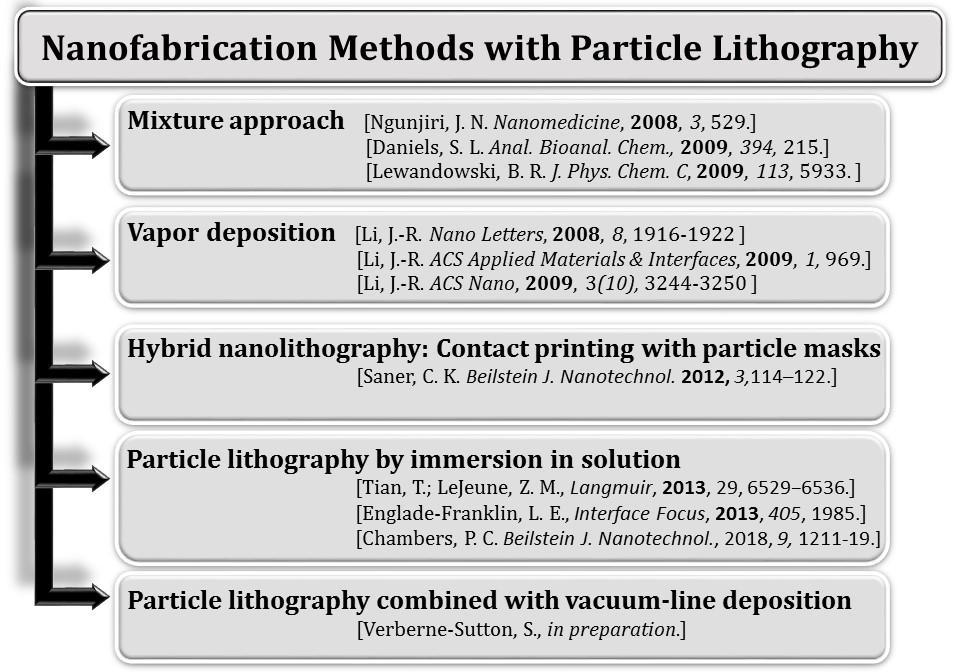
The natural arrangement of latex or silica spheres provide a template for making nanostructures
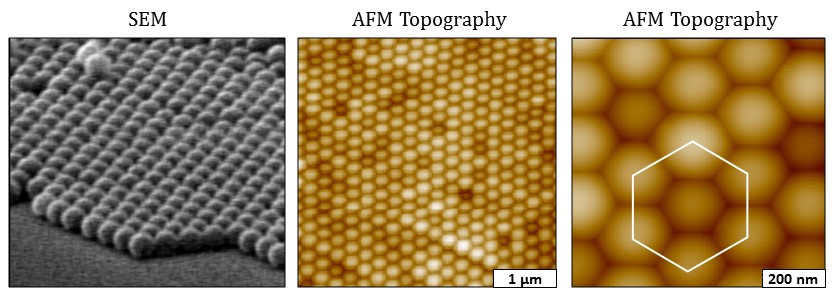 Arrangement of latex spheres on flat surfaces. When dried, colloidal suspensions of
latex or silica beads spontaneously form films of close-packed spheres.
Arrangement of latex spheres on flat surfaces. When dried, colloidal suspensions of
latex or silica beads spontaneously form films of close-packed spheres.
For approaches based on particle lithography, nanopatterns are made with a surface mask of monodisperse latex or silica mesospheres. After the particles are removed, exposed sites of the substrate are available for further steps of chemical reactions. [Li, J.-R.; Henry, G. C.; Garno, J. C. Fabrication of nanopatterned films of bovine serum albumin and staphylococcal protein A using latex particle lithography. Analyst, 2006, 131, 244–250.]
Nanostructures of PEO-silane prepared from 150 nm latex masks
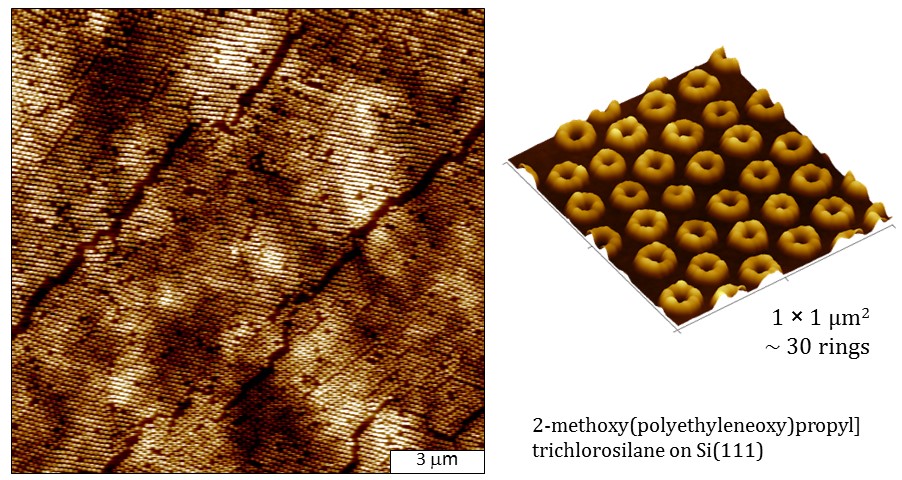
Particle lithography is a practical way to generate millions of high-density nanostructures without the need for vacuum environments, expensive instrumentation or iterative single-molecule manipulation. We have successfully developed methods for patterning ω-functionalized organosilanes on smooth, atomically flat surfaces such as gold, glass, quartz, crystalline silicon wafers, and Muscovite mica.
Control of surface coverage and density at the nanoscale
 Within the 1 micron frames, the size, arrangement and surface density of PEO-silane
rings is determined by the diameter of the latex spheres used as a surface mask. (vapor
deposition)
Within the 1 micron frames, the size, arrangement and surface density of PEO-silane
rings is determined by the diameter of the latex spheres used as a surface mask. (vapor
deposition)
Reproducibility of fabricating nanostructures of organosilanes with particle lithography
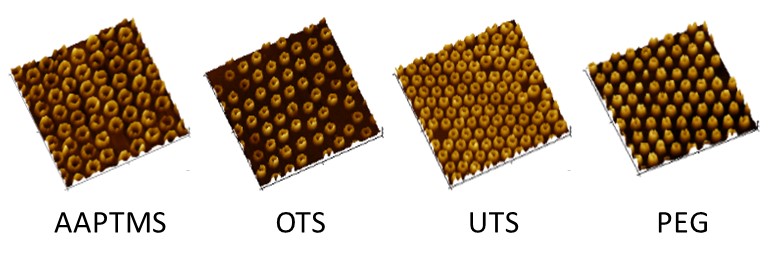 Ring nanostructures of organosilanes prepared with particle lithography using vapor
deposition with a surface mask of 200 nm latex spheres. Contact mode AFM topography
views 2 × 2 μm2) are shown of samples prepared with N-(6-aminohexyl)aminopropyl-trimethoxysilane
(6-AAPTMS); octadecyltrichlorosilane (OTS); 10-undecenyl-trichlorosilane (UTS); and
2-[methoxy(polyethyleneoxy)propyl]trimethoxysilane (PEG).
Ring nanostructures of organosilanes prepared with particle lithography using vapor
deposition with a surface mask of 200 nm latex spheres. Contact mode AFM topography
views 2 × 2 μm2) are shown of samples prepared with N-(6-aminohexyl)aminopropyl-trimethoxysilane
(6-AAPTMS); octadecyltrichlorosilane (OTS); 10-undecenyl-trichlorosilane (UTS); and
2-[methoxy(polyethyleneoxy)propyl]trimethoxysilane (PEG).
Billions of nanostructures can be prepared on surfaces using a few simple steps with high reproducibility and relatively few defects. Particle lithography provides a robust and highly reproducible approach for patterning alkylthiols, trichlorosilanes or trialkoxysilanes.
Nanostructures of octadecyltrisiloxane produced on Au(111) using particle lithography

Water-directed assembly of OTS on oxidized surfaces of Au(111) viewed for 5 × 5 μm2 AFM topographs: (left) untreated Au(111) substrate; (center) OTS film produced using vapor deposition with particle lithography; (right) ring-shaped nanostructures of OTS produced by vapor deposition through surface masks of 300 nm latex.
Successful results for preparing OTS nanopatterns on gold substrates are demonstrated with contact-mode AFM studies. To improve the wettability of the Au(111) surfaces, the substrates were exposed to UV irradiation before depositing aqueous solutions of latex. The masks of latex produced with particle lithography were used to define the surface sites of nanoscopic residues of water. [Lusker, K. L.; Li, J.-R.; Garno, J. C. ACS Applied Materials & Interfaces, 2009, 1, 969.]
Solvent-responsive properties of octadecyltrichlorosiloxane
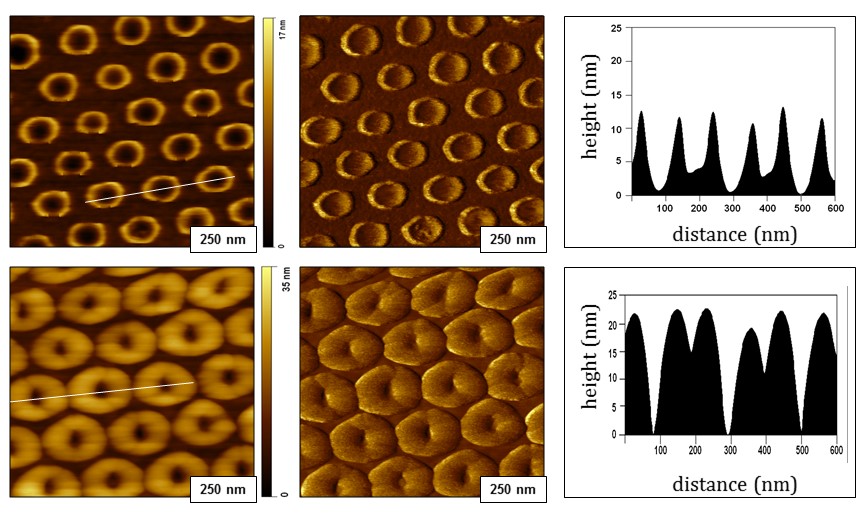
Side-by-side comparison of OTS nanostructures prepared with 200 nm latex spheres imaged in air (top row) and with immersion in liquid (bottom row) (left) topography image; (center) simultaneously acquired lateral force image; (right) height profile (white line)
In dry, ambient conditions, nanostructures of OTS were first imaged using contact mode atomic force microscopy (AFM). Next, ethanol or buffer was introduced to the sample cell, and images were acquired using the same probe. We observed substantial changes in the lateral and vertical dimensions of the ring nanostructures in AFM topography frames; the sizes of the rings were observed to swell by tens of nanometers. Even after heat treatment of samples to promote cross-linking, the samples still evidenced swelling in liquid media. [Kulkarni, S.; Lyles, V. D.; Serem, W. K.; Kumar, R.; Garno, J. C. Solvent-responsive properties ofoctadecyltrichloro- siloxane nanostructures investigated using atomic force microscopy in liquid. Langmuir, 2014, 30, 5466–5473]